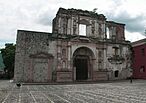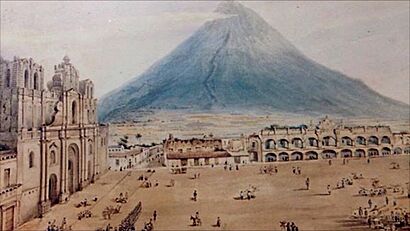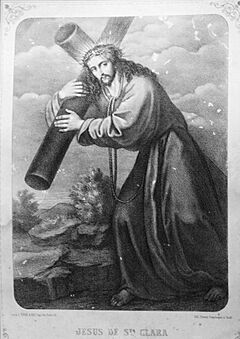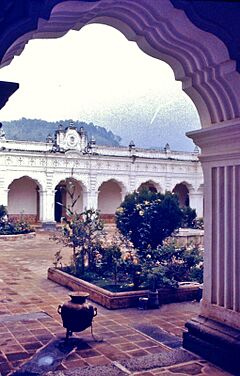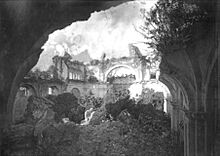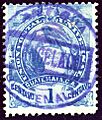Antigua Guatemala facts for kids
Quick facts for kids
Antigua Guatemala
|
|||
|---|---|---|---|
|
City
|
|||
|
Fountain of the Sirens
City Hall of Antigua Guatemala
Church of San Pedro
|
|||
|
|||
| Nickname(s):
La Antigua or Antigua Guatemala
|
|||
| Country | |||
| Department | |||
| Government | |||
| • Type | municipal | ||
| Elevation | 1,545 m (5,069 ft) | ||
| Population
(2023)
|
|||
| • Total | 60,608 | ||
| Climate | Cwb | ||
| Website | http://muniantigua.gob.gt/ | ||
| UNESCO World Heritage Site | |||
| Criteria | Cultural: ii, iii, iv | ||
| Inscription | 1979 (3rd Session) | ||
Antigua Guatemala, often called Antigua, is a beautiful city in the central highlands of Guatemala. Its name means "Old Guatemala." From 1543 to 1773, it was the capital of a large Spanish colony called the Captaincy General of Guatemala. Many of its buildings and streets still show the old Baroque style from that time. Because of its unique history and architecture, UNESCO made it a World Heritage Site in 1979. Today, Antigua Guatemala is the main city of the Sacatepéquez Department.
Contents
- How Many People Live in Antigua?
- The Story of Antigua Guatemala
- Antigua Guatemala Today
- Economy of Antigua
- Learn Spanish in Antigua
- Sports in Antigua
- Delicious Food in Antigua
- Volcanoes Around Antigua
- Exploring Antigua: Tourism
- Antigua in Movies
- Climate in Antigua
- Where is Antigua Located?
- Images for kids
- See also
How Many People Live in Antigua?
In the 1770s, about 65,000 people lived in Antigua. But after a big earthquake in 1773, most people moved away. By the 1990s, the city's population was still only half of what it used to be. In 2007, about 34,685 people lived there. Today, the population is around 60,608.
The Story of Antigua Guatemala
Antigua Guatemala was actually the third capital city of Guatemala. The first capital was founded in 1524. It was built on the site of a Kaqchikel-Maya city called Iximche. This city was named "Santiago de los Caballeros de Guatemala." Saint James (Santiago) became its patron saint.
After some local uprisings, the capital moved in 1527 to a valley called Almolonga. It kept the same name. But in 1541, a huge mudslide (called a lahar) from the Volcán de Agua destroyed this city.
So, in 1543, the Spanish leaders decided to move the capital again. They chose a new spot in the Panchoy Valley. This is where present-day Antigua stands. It was also named Santiago de los Caballeros. For over 200 years, this city was the center of the Spanish colony of Guatemala. This colony included most of Central America and even parts of Mexico.
The city was planned in a grid pattern. Streets ran north-south and east-west, with a main square in the middle. Important buildings like churches and government offices were built around this square. The city is surrounded by three large volcanoes, mountains, and hills.
Early Buildings and Earthquakes
The first religious group to settle in the new capital was the Franciscans. They built a chapel, but it was destroyed by an earthquake in 1575. They then built a larger complex nearby. This Franciscan center became very important for culture and religion.
The first cathedral started being built in 1545. It used materials from the old destroyed city. However, earthquakes often damaged its construction. The famous Spanish writer Bernal Díaz del Castillo was buried in one of the churches here.
Royal buildings for the governor and other officials began construction in 1558. These included the Royal Treasury, a jail, and army quarters.
Many earthquakes hit the city in the 16th century:
- March 21, 1530
- September 11, 1541
- 1565
- 1575
- November 30, 1577
- December 23, 1585
In 1566, King Felipe II of Spain gave the city a special title: "Very Noble and Very Loyal."
Important Events in the 17th Century
The Jesuits opened a school in 1608 called "San Lucas." It became very famous for teaching literature and grammar. Many important people from the city's noble families studied there.
In 1636, the monks of San Juan de Dios started their hospital and monastery. They were in charge of hospitals throughout the Kingdom of Guatemala.
Saint Hermano Pedro
Pedro de San José Betancourt, known as Saint Hermano Pedro, arrived in Guatemala in 1650. He became a Franciscan and dedicated his life to helping the poor, sick, and homeless. He founded the Order of the Brothers of Our Lady of Bethlehem in 1656. He wrote several books and is seen as a great evangelist. Hermano Pedro was also a pioneer in teaching reading and writing to people who couldn't read. He was a champion for human rights.
Royal and Pontifical University
The first bishop of Guatemala, Francisco Marroquín, wanted a university in Guatemala. He left money in his will to start a school. After many years of requests, King Carlos II finally allowed a university to be built in 1676.
The university, called the "Royal and Pontifical University of San Carlos Borromeo," opened its doors in 1681. It taught subjects like law, medicine, philosophy, and languages. Its rules were based on the famous Universidad de Salamanca in Spain.
Major Earthquakes in the 18th Century
The San Miguel Earthquake
The city of Santiago de los Caballeros faced its strongest earthquakes before 1776 in 1717. These were called the San Miguel earthquakes. People at the time believed natural disasters were a sign of divine punishment. They also thought the nearby Volcán de Fuego (Volcano of Fire) caused the quakes.
On August 27, 1717, Volcán de Fuego erupted for several days. On September 29, a strong earthquake hit the city. It damaged many buildings, including parts of the Royal Palace. Some people left the city, and there were food shortages. Despite the damage, the city's residents strongly opposed moving the capital. So, the city stayed put, and repairs were made.
The San Casimiro Earthquake
On March 4, 1751, the San Casimiro earthquake struck again. The roof of the Jesuit church collapsed. After this quake, the city actually saw improvements. Streets were beautified, and a new water system was installed.
The Santa Marta Earthquakes
In 1773, the Santa Marta earthquakes caused massive destruction. This time, the Spanish Crown decided the capital had to move. In 1776, the capital was moved to a safer place, which is now Guatemala City. The new capital was named Nueva Guatemala de la Asunción.
The badly damaged city of Santiago de los Caballeros was ordered to be abandoned. Not everyone left, though. From then on, it was called "la Antigua Guatemala," meaning "the Old Guatemala." Many old buildings were left as ruins.
Antigua in the 19th Century
After Guatemala became independent from Spain in 1821, many church properties became public. In 1829, many religious orders were expelled from Central America. Their buildings were often turned into schools or other public spaces.
By 1850, Antigua had about 9,000 people. Some old church buildings were even used as factories. In 1884, the City Hall planned to turn the old Jesuit buildings into a market, despite protests from local shop owners. A market was finally set up there in 1912.
Antigua in the 20th Century
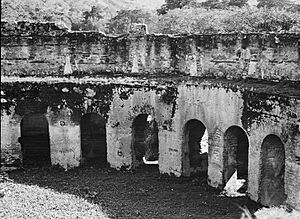

In 1920, Prince Wilhelm of Sweden visited Antigua. He wrote about the poor condition of the roads and the ruins. He noted that many churches were still in ruins from the 1773 earthquake and later quakes in 1917-1918. He saw animals grazing inside some old churches and families living in others.
However, some monuments were in better shape. The Escuela de Cristo was well-preserved. The old Capuchin monastery was also interesting, with its unique circular cells.
UNESCO World Heritage Site
In 1979, Antigua Guatemala was named a UNESCO World Heritage Site. This was because of its amazing Spanish Baroque architecture, its city plan, and its importance during the early colonial period.
Antigua Guatemala Today
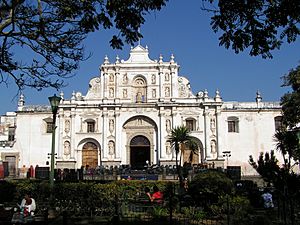
The heart of Antigua is its Central Park (Parque Central). The reconstructed fountain there is a popular meeting spot. To the north, you'll find the Arco de Santa Catalina, a famous landmark.
Antigua is known for its beautiful religious celebrations during Lent and Holy Week. Every Sunday during Lent, a local church holds a procession through the streets. People create amazing carpets on the ground using dyed sawdust, flowers, and even fruits and vegetables for these processions.
Antigua is very popular with tourists. It has a well-developed tourism industry. Many visitors use Antigua as a base to explore other parts of Guatemala. It's also a favorite place for people from the US and Europe to retire.
Economy of Antigua
Historically, the area around Antigua was known for its great farming. Today, tourism is the main driver of the economy. Antigua is also a famous region for growing coffee.
Learn Spanish in Antigua
Antigua is a top spot for learning Spanish through immersion. Many Spanish language schools are located here. Students from all over the world come to Antigua to study Spanish. These language institutes are a major industry, along with tourism.
Sports in Antigua
The local football (soccer) club, Antigua GFC, plays in Guatemala's top league. Their home stadium is the Estadio Pensativo. They are nicknamed Los panzas verdes ("Green bellies") and have won the national title four times since 2015.
Delicious Food in Antigua
Antigua has many restaurants offering food from all over the world. You can find small eateries at the Antigua marketplace. Here, you can try traditional Guatemalan dishes. A typical breakfast might include refried beans, fried eggs, fried plantains, and fresh cheese, served with handmade tortillas. You can also find Mediterranean, Italian, Asian, American, and French food.
Volcanoes Around Antigua
Three large volcanoes stand tall around Antigua.
- The most impressive one is Volcán de Agua (Volcano of Water), to the south. It's about 3,766 meters (12,356 feet) high. The local Kakchikel Mayas call it Hunapú. It got its Spanish name after a mudslide from it buried the second capital city.
- To the west are Acatenango and Volcán de Fuego (Volcano of Fire). Acatenango is about 3,976 meters (13,045 feet) high and last erupted in 1972.
- "Fuego" is famous for being almost constantly active. Steam and gas come from its top almost every day. A larger eruption happened in September 2012.
Exploring Antigua: Tourism
Antigua is a growing tourist spot. It's close to Guatemala City but is much calmer and safer. Many travel agencies offer shuttles from Antigua to other popular places in Guatemala. These include Monterrico beach, Atitlan Lake, and Tikal. Antigua is also known for its chocolate makers.
Historic Buildings of Antigua
Before 1944, many of the city's ruins were left abandoned. Some churches, like Nuestra Señora del Carmen and the Society of Jesus, survived the 1773 earthquake well. But they were later damaged by quakes in 1917-1918 and 1976.
The San Francisco El Grande church was in good shape after the 1773 and 1917 quakes. It was rebuilt in 1967, which helped it survive the 1976 earthquake. The La Merced church was almost new in 1773 and has stood strong since then.
| Name | Picture | Brief description |
|---|---|---|
| Captain General Palace | 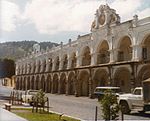 |
This was the home of the main governor of Guatemala during the Spanish rule. After the 1773 earthquake, it was left empty and used as a storage building. Today, it holds government offices and the police headquarters. |
| City Hall |  |
This building serves as the local government office for the city. |
| Cathedral of Saint James San José Parish |
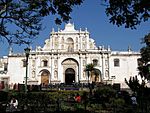 |
The first cathedral started in 1545. It was often damaged by earthquakes. A new one opened in 1680. It became a full cathedral in 1743. The remains of the famous conqueror Pedro de Alvarado were once here, but they disappeared after an earthquake. |
| Church and Convent of Capuchins |  |
This convent was approved in 1725 and finished in 1736. The nuns who lived here followed very strict rules of poverty and fasting. After the 1773 earthquake, its valuable items were moved to the new capital. |
| La Recolección | 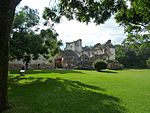 |
Two missionaries arrived in 1685 and wanted to build a monastery. The city first said no, but the king allowed it in 1700. Construction began in 1701, and the church opened in 1717. |
| San Francisco |  |
This was the first church built in Santiago de los Caballeros in the 1500s. It was damaged by many earthquakes over the years. After being abandoned for nearly 200 years, the Franciscans returned and reopened it. It has a special chapel with the remains of Saint Hermano Pedro. |
| La Merced Church | 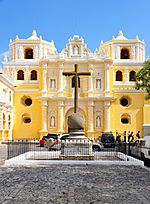 |
Construction of this church began in 1749 and it opened in 1767. It has a unique Guatemalan Baroque style with two bell towers. |
| Church and School of the Society of Jesus | 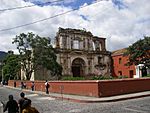 |
This complex was built with money from people like the writer Bernal Diaz del Castillo. It housed the famous "Colegio de San Lucas," a school for the city's elite. Even though it survived the 1773 earthquake, later quakes in 1917-18 and 1976 destroyed it. |
| Santo Domingo Monastery |  |
This was once one of the largest and most important monasteries. It was destroyed in 1773 and abandoned. The ruins were later sold and turned into the Hotel Casa Santo Domingo in 1989. |
| Escuela de Cristo Church |  |
This church was founded in 1664. It was damaged in the 1717 earthquake and rebuilt. Its stone facade has a Renaissance style, making it stand out from other churches. Saint Hermano Pedro's remains were originally here. |
| Nuestra Señora del Carmen Church | 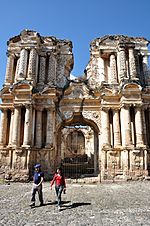 |
This church survived the Santa Marta earthquakes but was almost destroyed by the 1917-18 and 1976 quakes. However, its beautiful facade is still in great condition and is a famous example of Guatemalan Baroque style. |
| San Pedro Hospital | 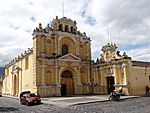 |
The monks of San Juan de Dios started their first hospital in 1636. They were in charge of hospitals throughout the Kingdom of Guatemala. San Pedro Hospital was specifically for church members. |
| La Concepción convent |  |
This convent was once thought to be the palace of a famous nun, Juana de Maldonado. But new studies show it was built in the 1700s, after she lived. |
| Chapel of the Holy Cross | 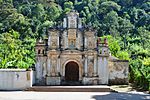 |
Holy Week Celebrations
Antigua is famous for its Holy Week celebrations. These are some of the most traditional processions:
| Day | Picture | Church | Hours |
|---|---|---|---|
| Fifth Sunday of Lent | Jesús de la Caída | San Bartolomé Becerra | 7:00 am – 10:00 pm |
| Friday of Sorrows | Viacrucis del Hermano Pedro (men) | San Francisco el Grande | 3:00 pm – 6:00 pm |
| Palm Sunday | Palm procession | Jocotenango Sacatepéquez | 6:30 am – 12:00 pm |
| Palm procession (live show) | La Merced, Santa Ana, Escuela de Cristo, San Felipe de Jesús | 8:00 am – 12:00 pm | |
| Jesús Nazareno de la Reseña | La Merced | 11:00 am – 11:00 pm | |
| Holy Monday | Jesús Nazareno | Santa Inés del Monte Pulciano | N/A |
| Holy Tuesday | Jesús Nazareno del Silencio | El Calvario | 4:00 pm – 11:00 pm |
| Holy Wednesday | Jesús Nazareno del Milagro | San Felipe de Jesús | 2:50 pm – 10:00 pm |
| Jesús Nazareno | San Mateo Milpas Altas | 4:00 pm – 10:00 pm | |
| Holy Thursday | Jesús Nazareno de la Humildad | San Cristóbal el Bajo | 11:00 am – 10:00 pm |
| Jesús Nazareno del Perdón | San Francisco el Grande | 1:00 pm 12:00 am | |
| Good Friday | Jesús Nazareno de la Penitencia | La Merced | 4:00 am – 3:00 pm |
| Crucifixion | Antigua Guatemala Cathedral, Escuela de Cristo | 12:00 pm – 3:00 pm | |
| Señor Sepultado and Virgen de Soledad | Antigua Guatemala Cathedral | 3:00 pm – 1:00 am | |
| Señor Sepultado | San Felipe de Jesús | 3:00 pm – 1:00 am | |
| Señor Sepultado | Escuela de Cristo | 4:00 pm – 1:00 am |
Art in Antigua
Antigua is also home to the National Museum of Guatemalan Art. It is located in the Palace of the Captaincy General. This building is a World Heritage Site from the 16th century.
Antigua in Movies
The New Adventures of Tarzan (1935)
In 1935, parts of the movie The New Adventures of Tarzan were filmed in Guatemala. Antigua Guatemala was used for scenes of the Green Goddess temple. Other locations included Chichicastenango, Río Dulce, and Tikal.
The Border: 1982
The first earthquake scenes in the 1982 film The Border, starring Jack Nicholson, were filmed in Antigua Guatemala. Specifically, they were shot at the La Recoleccion Architectural Complex.
Climate in Antigua
Antigua Guatemala has a subtropical highland climate. This means it has mild temperatures all year round.
| Climate data for Antigua Guatemala | |||||||||||||
|---|---|---|---|---|---|---|---|---|---|---|---|---|---|
| Month | Jan | Feb | Mar | Apr | May | Jun | Jul | Aug | Sep | Oct | Nov | Dec | Year |
| Mean daily maximum °C (°F) | 22.5 (72.5) |
23.4 (74.1) |
24.7 (76.5) |
25.0 (77.0) |
24.7 (76.5) |
23.6 (74.5) |
23.5 (74.3) |
23.8 (74.8) |
23.1 (73.6) |
22.7 (72.9) |
22.8 (73.0) |
22.3 (72.1) |
23.5 (74.3) |
| Daily mean °C (°F) | 16.6 (61.9) |
17.2 (63.0) |
18.3 (64.9) |
19.1 (66.4) |
19.5 (67.1) |
19.4 (66.9) |
19.0 (66.2) |
19.0 (66.2) |
18.7 (65.7) |
18.3 (64.9) |
17.7 (63.9) |
16.8 (62.2) |
18.3 (64.9) |
| Mean daily minimum °C (°F) | 10.8 (51.4) |
11.1 (52.0) |
11.9 (53.4) |
13.3 (55.9) |
14.3 (57.7) |
15.3 (59.5) |
14.6 (58.3) |
14.3 (57.7) |
14.4 (57.9) |
13.9 (57.0) |
12.7 (54.9) |
11.3 (52.3) |
13.2 (55.7) |
| Average precipitation mm (inches) | 1 (0.0) |
3 (0.1) |
4 (0.2) |
25 (1.0) |
118 (4.6) |
231 (9.1) |
170 (6.7) |
141 (5.6) |
220 (8.7) |
131 (5.2) |
16 (0.6) |
5 (0.2) |
1,065 (42) |
| Source: Climate-Data.org Instituto Nacional de Sismología, Vulcanología, Meteorología e Hidrología de Guatemala |
|||||||||||||
Where is Antigua Located?
Antigua Guatemala is surrounded by several towns in the Sacatepéquez area:
 |
Santo Domingo Xenacoj, Jocotenango and Pastores |  |
||
| San Antonio Aguas Calientes | San Bartolomé Milpas Altas, Santa Lucía Milpas Altas, Magdalena Milpas Altas | |||
| Ciudad Vieja | Santa María de Jesús |
Images for kids
See also
 In Spanish: Antigua Guatemala para niños
In Spanish: Antigua Guatemala para niños








